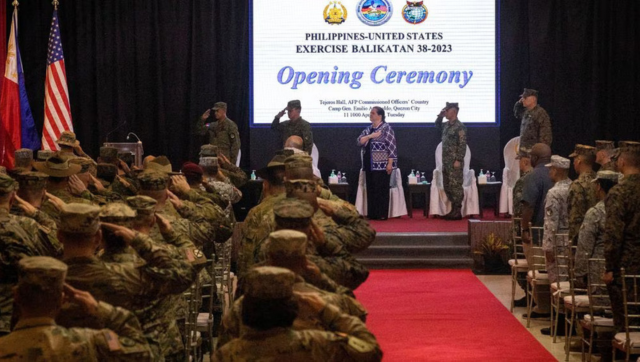Manila (Philippines): In the Philippines and its waters across the disputed South China Sea and the Taiwan Strait, where Washington has frequently cautioned Beijing over its more aggressive moves, US and Filipino soldiers on Tuesday began their largest combat exercises in decades. More than 17,600 military troops will participate in the yearly exercises by the old treaty friends known as Balikatan, which means “shoulder to shoulder” in Filipino. They will last until April 28. As the Joe Biden administration fortifies an arc of alliances to better fight China, especially in a potential showdown over Taiwan, an island democracy that Beijing claims as its own, it will be the latest demonstration of American firepower in Asia. This is consistent with the Philippines’ efforts under President Ferdinand Marcos Jr. to defend its territorial interests in the South China Sea, which China claims almost entirely. These efforts included stepping up joint military drills with the U.S. and agreeing in 2014 to a defence agreement that allowed rotating groups of American forces to stay in additional Philippine military camps. “The relationships that we have, that we build into these exercises, will make us faster to respond to conflict, crisis, humanitarian assistance and disaster relief,” U.S. Marine Maj. Gen. Eric Austin said. The drills are the largest since Balikatan began three decades ago and involve some 12,200 U.S. military personnel, 5,400 Filipino forces, and 111 Australian equivalents. According to U.S. and Filipino military officials, the exercises will display American warships, fighter planes, Patriot missiles, HIMARS rocket launchers, and anti-tank Javelins. According to Col. Michael Logico, a Philippine spokesman for Balikatan, on April 26 U.S. and Filipino forces will sink a target ship in a live-fire drill for the first time in Philippine territorial waters off the western province of Zambales through a coordinated inland and coastal artillery bombardment and airstrike. “We have to fire at a target that is closer to what we would expect in an actual threat, which is an intrusion coming from an adversary by sea. We are demonstrating that we are combat ready,” Logico was quoted as saying by news agency Reuters. When asked if Marcos expressed any fear that Beijing would become enraged by the rocket launch along the busy waterway that China believes to be its territory, Logico replied that it was not brought up during the briefing. “Marcos wants to witness the live-fire drill,” he said. “In western Palawan province, which faces the South China Sea, the exercises will involve retaking an island captured by enemy forces,” Logico added. The exercises, according to Philippine military authorities, were not directed at any one nation but rather at strengthening the nation’s coastline defence and disaster response skills. According to the U.S. Embassy in Manila, these field exercises would “test the partners’ capabilities in combined arms live-fire, information and intelligence sharing, communications between manoeuvre units, logistics operations, and amphibious operations.” The Filipino foreign and defence ministers will meet with their American counterparts in Washington on Tuesday to discuss the US military presence and potential coordinated naval patrols, which is an indication of the two countries’ growing defence cooperation, according to officials. The long-running territorial disputes between China, the Philippines, and four other states, as well as Beijing’s intention to conquer Taiwan, using force if necessary, have set Washington and Beijing on a collision course. China sent a warning last week about the growing American military presence in the area. That “would only result in greater tensions and less peace and stability in the region,” according to Mao Ning, a spokesman for the Chinese Foreign Ministry, during a routine news briefing in Beijing. The Taiwanese President Tsai Ing-wen met with House Speaker Kevin McCarthy last week in California, which incensed Beijing. As a result, Beijing conducted three days of war drills simulating the sealing off of Taiwan, which ended the day after the Philippines’ Balikatan exercises began. Monday saw the deployment of the USS Milius, a guided-missile destroyer, within 12 nautical miles of Mischief Reef, a coral outcrop claimed by Manila that China had taken over in the mid-1990s and turned into one of seven missile-protected island bases in the tensely disputed Spratlys archipelago in the South China Sea. Such freedom of navigation operations have been carried out by the U.S. military for years in an effort to counter China’s broad territorial claims. “As long as some countries continue to claim and assert limits on rights that exceed their authority under international law, the United States will continue to defend the rights and freedoms of the sea guaranteed to all,” the 7th Fleet said.
US, Philippines hold massive military exercise in South China Sea
FP Staff
• April 11, 2023, 22:18:05 IST
As the Joe Biden administration fortifies an arc of alliances to better fight China, especially in a potential showdown over Taiwan, an island democracy that Beijing claims as its own, it will be the latest demonstration of American firepower in Asia
Advertisement
)
End of Article